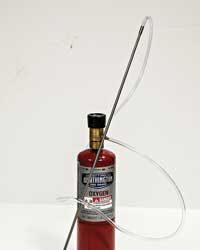Aerating Wort Techniques
Oxygen in beer is undesirable except at one point (and only one point) in the brewing process. That lone point is when the post-boil wort has been chilled down to fermentation temperature, but before the yeast has been pitched into it.
Oxygen dissolves into wort as a function of temperature and specific gravity. As such, the colder and less concentrated the wort, the more oxygen will be able to enter into solution. All the bubbling and splashing that occurs during the boil drives most of the oxygen out of solution because the wort is too hot while boiling. Therefore, oxygen must be replenished after the wort is cool and able to retain the oxygen in solution again.
Oxygen is essential for yeast growth and reproduction. Yeast must grow and reproduce first, before actually fermenting the wort to make beer. Yeast needs oxygen to synthesize the material for expanding cell walls; namely sterols and fatty acids. Overlooking proper wort aeration can lead to problems such as long lag times before the start of fermentation, stuck or incomplete fermentation, or excessive ester (fruit flavor) production, any of which would produce less than desired results. Now that we understand the “when” and “why” of wort aeration, let’s examine how homebrewers can supply oxygen to chilled wort to meet the needs of their chosen favorite fungi.
Commercial breweries typically shoot for 8 to 10 ppm dissolved oxygen in wort prior to fermentation. Five ppm dissolved oxygen in wort is considered a bare minimum for proper yeast growth. Eight ppm of oxygen in chilled wort can be achieved using plain old air (which is 21% oxygen). Oxygen saturation above eight ppm in wort usually requires the use of pure oxygen. Again, as the specific gravity of wort increases, its ability to absorb oxygen decreases, thus making wort oxygenation of big beers even more critical to their successful production. Because it is difficult and expensive for homebrewers to measure dissolved oxygen in wort, experimentation will be needed in order to determine if the oxygenation method you perform is sufficient. If your fermentation temperature and yeast pitching rate are good, but fermentation is sluggish or incomplete, you should look at stepping up your oxygenation technique for future batches until you achieve success. There are three approaches homebrewers typically use to oxygenate wort; agitation, splashing and injection of either air or pure oxygen.
Wort Agitation
After the wort has been chilled and transferred to the primary fermenter, there are a number of methods that can be employed to agitate the wort to introduce oxygen. If your wort is in a glass carboy, you can cover the mouth of the carboy with a loose fitting cap, get a firm grip and rock the carboy forth and back to slosh the wort around inside. Care must be taken to support the carboy on a cushioned surface and to maintain a secure hold on the carboy at all times while agitating.
If your wort will be fermented in a bucket or other vessel with a wide open top, a stainless steel whisk borrowed from the kitchen can be sanitized and used to whip the wort until it has at least a couple inches (several centimeters) of foam on top. If you don’t think your arm will last long enough to manually whisk the wort, you can sanitize a (new) paint stirrer, attach it to an electric drill and agitate the wort accordingly. A word of caution if using an electric drill and paint stirrer: be sure the drill is connected to a ground-fault protected receptacle, take care not to damage the fermenting vessel (or yourself), and avoid splashing the wort out
of the fermenter.
Regardless if your wort is in either a carboy or bucket, if you need to add cold water to make up the volume of wort to the desired level, splashing or spraying the cold water into the wort can also increase the amount of oxygen that will go into solution. Agitation is the simplest and least expensive method for aerating wort, but involves a little more time and elbow grease than splashing or injection.
Splashing
Another opportunity to add oxygen to your batch of homebrew is when the chilled wort is being transferred from the kettle to the fermenter. If the transfer is taking place through some type of hose or tubing, attaching a sanitized bent pen clip or other device (such as a Fermentap Siphon Spray) to the end of the tubing will cause the wort to spray and splash as it enters the fermenter. If you have two sanitized vessels, you can transfer the wort between the two (at least five or six times) with as much splashing as practical. Pouring the wort through a sanitized wire mesh strainer can also increase splashing during the wort transfer process. As with agitation, splashing should result in at least a couple inches of foam on the wort surface. Be sure to brace the container receiving the wort so it cannot move and cause spilled wort. Also, be certain that containers and strainers are thoroughly sanitized before use. Splashing is a relatively simple and inexpensive approach to oxygenation, but if accomplished by pouring wort between vessels it may lend itself to contamination from airborne microbes.
O2 Injection
Perhaps the most effective approach to oxygenate wort is to directly inject air or pure oxygen into the wort. This can be done after the wort has been chilled in the kettle and conveyed to the fermenter, or during the delivery of wort from a wort chiller to a fermenter. While this technique is very effective, it usually involves more equipment and expense than both the agitation and splashing methods
previously described.
The most common method of oxygen injection used by homebrewers is to infuse air or oxygen into the wort after it has been chilled and transferred to the primary fermenter. This technique uses either pressurized air or oxygen and some type of diffuser to bubble the gas into the wort to get oxygen into solution.
To accomplish oxygenation using air, an aquarium pump (or other air compressor) can be used to pressurize the air and send it through tubing and some type of filter to remove dust and/or microorganisms. A HEPA (High Efficiency Particulate Air) filter with a .023 micron sized filter, or a filter improvised from cotton balls wetted with alcohol is recommended to keep the air as contaminant-free as possible as it enters the wort. Many homebrew suppliers now carry air pumps, filters and diffusers for this method of wort oxygenation.
Simply running air from the end of a section of tubing into the wort is not a very efficient means of gas transfer as the bubbles will be few in number and large in size. To get the most efficient transfer of oxygen into solution, some sort of diffusing apparatus is necessary at the end of the tube immersed in the wort. Diffusers range from very inexpensive aquarium-type air diffusion stones to sintered stainless steel diffusers.
Aquarium stones are inexpensive, but less efficient than a 0.5 micron stainless steel diffuser, which is preferred from both an efficiency and longevity standpoint. The small 0.5 micron holes in a stainless steel diffuser create a profusion of very tiny bubbles that create a larger gas to liquid surface area to dissolve oxygen into the wort with greater efficiency. A stainless steel diffuser can be sanitized by boiling it in water for 15 minutes prior to use. Artificial stones designed for use in aquariums can be sanitized by a quick soak in vodka, but after a few uses become fragile and tend to disintegrate quite easily (as has been my personal experience).
When using pure oxygen instead of air to oxygenate wort, filtration is not necessary as it is unlikely for microorganisms to survive in an atmosphere as reactive as pure oxygen. Otherwise, the technique for using oxygen is the same as that used for air, except for the amount of time the gas is bubbled through the wort. Since air is only 21% oxygen, it takes more bubbles of air to dissolve the desired amount of oxygen into solution. An apparatus diffusing air into chilled (< 70 °F/21 °C) wort typically needs to run for a minimum of 15 minutes to achieve adequate oxygenation, where the same set-up using pure oxygen would require only a minute or two at the most to achieve the same result.
There are also ready-made apparatus for diffusing oxygen into a vessel of wort that include a cylinder of oxygen, gas regulator, tubing and a stainless steel diffuser. Commercial or industrial grade oxygen is all that is necessary for use in wort oxygenation. Aviation or medical grade oxygen is more expensive, difficult to obtain and is not necessary for the purposes of brewing. A word of caution when using pure oxygen: there are few things as flammable as pure gaseous oxygen, so be sure there are no sparks or flames in the vicinity of where the gas will be used.
A more sophisticated method of oxygenating wort is to inject air or pure oxygen into the wort as it passes from the kettle or chiller into the fermentation vessel. This is the approach commercial breweries commonly use to properly oxygenate their wort.
There are two basic techniques that can be used to inject air or oxygen into wort as it streams into the fermenter; by means of a simple venturi, or by injecting compressed air or oxygen into the flowing wort. The venturi approach can be accomplished by allowing the wort to flow through a section of tubing or pipe that has small (0.02 inches or 0.5 mm) holes drilled through it to allow air to be drawn into the tube as the liquid passes through it. A homemade venturi tube can be constructed. One drawback of some venturi systems, however, is that they lack a filter for the air being drawn into the wort, which creates an opportunity for microbial contamination.
An alternative to the venturi tube technique is to use pressurized air or pure oxygen which is directly injected into the wort stream. This can be accomplished by placing a tee in the wort transfer line and injecting the air or oxygen through a diffuser inside the tee as the wort streams past. Such a project is described by clicking here . The injection process lasts for as long as it takes to run the wort between vessels, resulting in all of the wort being exposed to the injected gas.
Simple regulators that attach to disposable oxygen cylinders that are equipped with a 1⁄4-inch barbed fitting are available from many homebrew suppliers. Disposable oxygen cylinders are available from most hardware stores. The gas regulators simply have a knob that is turned to adjust the pressure of the oxygen leaving the cylinder. This allows the user to release only enough gas to generate the desired degree of bubbling from a diffuser into the wort. Infusing air or oxygen into wort may generate a significant amount of foam that may overflow from a fermenter if left unmonitored. Anti-foaming agents made of food grade silicone are available from homebrew suppliers to control foaming during oxygenation without impacting head retention or flavor of the finished beer when they are used as recommended.
Oxygenation of cooled, post-boil wort is essential for proper fermentation by brewing yeast. To be successful, homebrewers must pay heed to this important step in the brewing process by selecting and implementing a successful wort oxygenation technique that fits their equipment and budget. Oxygen is critical for the growth of brewing yeast . . . and happy yeast makes for happy homebrewers!



